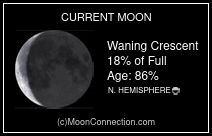Phases of the Moon
Phases Of The Moon
The lunar cycle has long guided society in Hawai’i. Click here for the Hawaiian Lunar Calendar from Kamehameha Publishing.
2025 Dates
New Moon | First Quarter | Full Moon | Third Quarter |
Look for the Moon near the Sun | Best phase for viewing the Moon in early evening hours | Appears to rise and set opposite of the Sun | Best phase for viewing the Moon in the hours before sunrise |
| January 6 | January 13 | January 21 |
January 29 | February 4 | February 12 | February 20 |
February 27 | March 6 | March 13 | March 22 |
March 29 | April 4 | April 12 | April 20 |
April 27 | May 4 | May 12 | May 20 |
May 26 | June 2 | June 10 | June 18 |
June 25 | July 2 | July 10 | July 17 |
July 24 | August 1 | August 7 | August 15 |
August 22 | August 30 | September 7 | September 14 |
September 21 | September 29 | October 6 | October 13 |
October 21 | October 29 | November 5 | November 11 |
November 19 | November 27 | December 4 | December 11 |
December 19 | December 27 |
|
|
Lunar Eclipses
Lunar eclipses occur when the Moon, Earth, and Sun align in a way that the Moon passes through Earth’s shadow. This occurs during the full moon phase, when the Moon is located on the opposite side of the Earth from the Sun. The Moon appears differently during a lunar eclipse depending on whether it is passing through the penumbra or umbra portions of Earth’s shadow.
These dates are limited to upcoming lunar eclipses visible at least in part from Honolulu, Hawaii. Times are listed in Hawaiian Standard Time (HST). Additional lunar eclipses are visible in 2025 from other locations on Earth.
Total Lunar Eclipse: March 13-14, 2025
- Various stages of lunar eclipse can be seen from moonrise on Thursday, March 13, about 6:32 p.m., through about 12:00 a.m. on Friday, March 14.
- Total lunar eclipse: expected between 8:24-9:32 p.m. During this period, majority of the Moon will be in the umbra and it will take on a reddish appearance.
- Moment of maximum eclipse: expected around 9:00 p.m. It will be easiest to see the red color of the Moon around this time.
- Leading up to and after the period of total lunar eclipse, portions of the Moon will appear to darken as it moves in and out of the penumbra (penumbral and partial eclipses).
Total Lunar Eclipse: March 2-3, 2026
- Various stages of lunar eclipse can be seen from Monday, March 2, beginning at about about 10:44 p.m., through about 4:23 a.m. on Tuesday, March 3.
- Total lunar eclipse: expected between 1:04-2:02 a.m. on Tuesday, March 3. During this period, majority of the Moon will be in the umbra and it will take on a reddish appearance.
- Moment of maximum eclipse: expected around 1:33 a.m. on Tuesday, March 3. It will be easiest to see the red color of the Moon around this time.
- Leading up to and after the period of total lunar eclipse, portions of the Moon will appear to darken as it moves in and out of the penumbra (penumbral and partial eclipses).
Super Full Moons
When a full moon is seen around the time the Moon approaches perigee, its closest distance to Earth in its elliptical orbit, it is commonly called a super full moon or supermoon. The term supermoon can also refer to a super new moon. In present day, the Moon moves between 226,000-251,000 miles (363,300-405,500 km) away from Earth over the course of its orbit.
The following super full moon dates indicate the moment of 100% illumination in Hawaiian Standard Time. The Moon will appear larger and brighter than the average full moon, and even more so when the Moon is viewed near the horizon. Explore NASA’s Daily Moon Guide for observation highlights for any selected day.
October 6, 2025, 5:48 p.m., visible after moonrise at 6:05 p.m.
November 5, 2025, 3:19 a.m., visible after moonrise the evening before, November 4, at 5:19 p.m.
December 4, 2025, 1:14 p.m. visible after moonrise at 5:45 p.m.
About the Planetarium
Bishop Museum’s Jhamandas Watumull Planetarium opened its doors on December 12, 1961. Originally called the Kilolani Planetarium, the Watumull Planetarium has served over six million visitors and students over 60 years of continuous operation. The Planetarium was instrumental in the recovery of the nearly lost art and science of traditional, non-instrument navigation in Hawaiʻi. Nainoa Thompson spent countless hours in the Planetarium with Will Kyselka and other Planetarium staff in the late 1970s learning how to read the night sky. We are honored to continue that legacy by serving as a training space for today’s navigators.
Our GOTO Chronos II optical star projector provides one of the most vivid, realistic recreations of the night sky available today, with 8,500 pinpoint stars and realistic, bright planets. Our Digistar 4K
full-dome video system covers the entire dome in immersive video, allowing us to fly through the rings of Saturn, into the depths of the Orion nebula, out to the edge of the universe, and even simulate a voyage across the Pacific.
The Planetarium has 64 seats and serves 70,000 people a year. The planetarium focuses on programs about Hawaiʻi, blending live and prerecorded elements within each program.


